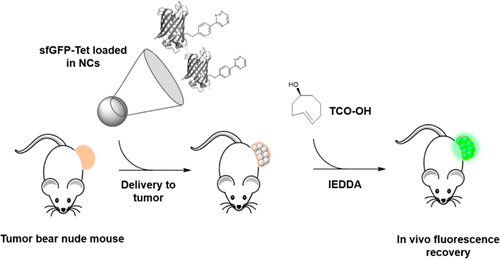当前位置:
X-MOL 学术
›
Bioconjugate Chem.
›
论文详情
Our official English website, www.x-mol.net, welcomes your
feedback! (Note: you will need to create a separate account there.)
Temporal Control of Efficient In Vivo Bioconjugation Using a Genetically Encoded Tetrazine-Mediated Inverse-Electron-Demand Diels–Alder Reaction
Bioconjugate Chemistry ( IF 4.0 ) Pub Date : 2020-10-09 , DOI: 10.1021/acs.bioconjchem.0c00497 Byungseop Yang 1 , Kiyoon Kwon 1 , Subhashis Jana 2 , Seoungkyun Kim 1 , Savanna Avila-Crump 2 , Giyoong Tae 1 , Ryan A Mehl 2 , Inchan Kwon 1
Bioconjugate Chemistry ( IF 4.0 ) Pub Date : 2020-10-09 , DOI: 10.1021/acs.bioconjchem.0c00497 Byungseop Yang 1 , Kiyoon Kwon 1 , Subhashis Jana 2 , Seoungkyun Kim 1 , Savanna Avila-Crump 2 , Giyoong Tae 1 , Ryan A Mehl 2 , Inchan Kwon 1
Affiliation

|
An inverse-electron-demand Diels–Alder (IEDDA) reaction using genetically encoded tetrazine variants enables rapid bioconjugation for diverse applications in vitro and in cellulo. However, in vivo bioconjugation using genetically encoded tetrazine variants is challenging, because the IEDDA coupling reaction competes with rapid elimination of reaction partners in vivo. Here, we tested the hypothesis that a genetically encoded phenylalanine analogue containing a hydrogen-substituted tetrazine (frTet) would increase the IEDDA reaction rate, thereby allowing for successful bioconjugation in vivo. We found that the in vitro IEDDA reaction rate of superfolder green fluorescent protein (sfGFP) containing frTet (sfGFP-frTet) was 12-fold greater than that of sfGFP containing methyl-substituted tetrazine (sfGFP-Tet_v2.0). Additionally, sfGFP variants encapsulated with chitosan-modified, pluronic-based nanocarriers were delivered into nude mice or tumor-bearing mice for in vivo imaging. The in vivo-delivered sfGFP-frTet exhibited almost complete fluorescence recovery upon addition of trans-cyclooctene via the IEDDA reaction within 2 h, whereas sfGFP-Tet_v2.0 did not show substantial fluorescence recovery. These results demonstrated that the genetically encoded frTet allows an almost complete IEDDA reaction in vivo upon addition of trans-cyclooctene, enabling temporal control of in vivo bioconjugation in a very high yield.
中文翻译:

时间控制有效的体内生物共轭使用基因编码的川tr嗪介导的逆电子需求Diels-Alder反应
使用遗传编码的四嗪逆电子需求狄尔斯-阿尔德(IEDDA)反应的变体能够快速生物缀合于不同的应用在体外和在纤维素的。但是,使用遗传编码的四嗪变体进行体内生物缀合具有挑战性,因为IEDDA偶联反应与体内快速消除反应伙伴竞争。在这里,我们测试了一个假设,即含有氢取代的四嗪(frTet)的基因编码的苯丙氨酸类似物会提高IEDDA反应速率,从而在体内成功实现生物偶联。我们发现体外含有frTet的超文件夹绿色荧光蛋白(sfGFP-frTet)的IEDDA反应速率比含有甲基取代的四嗪(sfGFP-Tet_v2.0)的sfGFP的IEDDA反应速率高12倍。另外,将被壳聚糖修饰的,基于普卢尼克的纳米载体封装的sfGFP变体递送至裸鼠或荷瘤小鼠体内进行成像。的体内-delivered的sfGFP-frTet表现出在经由在2小时内将反应IEDDA加入反式-环辛烯的几乎完全荧光恢复,而的sfGFP-Tet_v2.0没有显示出显着的荧光恢复。这些结果表明,遗传编码的frTet在添加反式环辛烯后可以在体内几乎完成IEDDA反应,从而可以暂时控制体内生物缀合的产率很高。
更新日期:2020-10-21
中文翻译:

时间控制有效的体内生物共轭使用基因编码的川tr嗪介导的逆电子需求Diels-Alder反应
使用遗传编码的四嗪逆电子需求狄尔斯-阿尔德(IEDDA)反应的变体能够快速生物缀合于不同的应用在体外和在纤维素的。但是,使用遗传编码的四嗪变体进行体内生物缀合具有挑战性,因为IEDDA偶联反应与体内快速消除反应伙伴竞争。在这里,我们测试了一个假设,即含有氢取代的四嗪(frTet)的基因编码的苯丙氨酸类似物会提高IEDDA反应速率,从而在体内成功实现生物偶联。我们发现体外含有frTet的超文件夹绿色荧光蛋白(sfGFP-frTet)的IEDDA反应速率比含有甲基取代的四嗪(sfGFP-Tet_v2.0)的sfGFP的IEDDA反应速率高12倍。另外,将被壳聚糖修饰的,基于普卢尼克的纳米载体封装的sfGFP变体递送至裸鼠或荷瘤小鼠体内进行成像。的体内-delivered的sfGFP-frTet表现出在经由在2小时内将反应IEDDA加入反式-环辛烯的几乎完全荧光恢复,而的sfGFP-Tet_v2.0没有显示出显着的荧光恢复。这些结果表明,遗传编码的frTet在添加反式环辛烯后可以在体内几乎完成IEDDA反应,从而可以暂时控制体内生物缀合的产率很高。











































 京公网安备 11010802027423号
京公网安备 11010802027423号